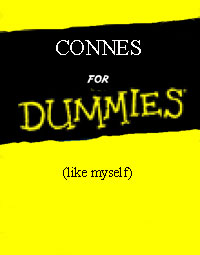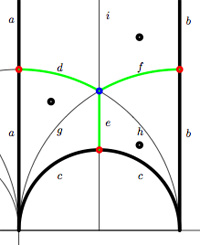What better way to start a series on Web 2.0 & Mathematics than to reflect on the potential dangers of majority-approved sites, such as Google, Wikipedia and META-sites. Bee has written a great essay The Spirits That We Called
Now you can tell me everyone of us should be rational, we should always check sources, doubt unverified reports even if repeated several times. We shouldn’t believe what we read without questioning it. We should seek accuracy and not easy entertainment. We should, we should, we should. But face it, many people don’t. Because they just don’t have the time, or are not interested enough, and the most commonly used criteria in this case is to follow the masses. Read what others read (the posts with the most comments?) go where many people link to, talk what others talk about, pay attention to what many people consider relevant. Majority offers security, Wikipedia is trustworthy, Google has proved useful.
To wet your appetite to take a break, and start reading the full essay (11 printed pages available from this pdf link), her opening paragraph, in which she outlines possible consequences of tempering with social bookmark sites.
MARCH 13th 2008: Until Wednesday, the Presidential candidate [insert name here] scored high in the polls. Then a Google search for his name showed up as first hit a report on an alleged child abuse committed by the candidate, published by Mary S. (name changed) on her personal website. The story was backed up by the following highly ranked hits that indicated two similar events during his youth, though reliable sources were missing. Within less than one hour, the reports were echoed on thousands of weblogs, appeared on digg and reddit, the original websites received 200,000 hits within the first 6 hours, until the server crashed down. Immediate press releases by the candidate’s PR groups did not appear on the Google listing, and could only be accessed by secondary links. It took until the next day that printed newspapers could attempt to clarify the situation.
Another, equally interesting essay, to which Bee points is Digital Maoism by Jaron Lanier,
The Wikipedia is far from being the only online fetish site for foolish collectivism. There’s a frantic race taking place online to become the most “Meta” site, to be the highest level aggregator, subsuming the identity of all other sites.
The race began innocently enough with the notion of creating directories of online destinations, such as the early incarnations of Yahoo. Then came AltaVista, where one could search using an inverted database of the content of the whole Web. Then came Google, which added page rank algorithms. Then came the blogs, which varied greatly in terms of quality and importance. This lead to Meta-blogs such as Boing Boing, run by identified humans, which served to aggregate blogs. In all of these formulations, real people were still in charge. An individual or individuals were presenting a personality and taking responsibility.
…
In the last year or two the trend has been to remove the scent of people, so as to come as close as possible to simulating the appearance of content emerging out of the Web as if it were speaking to us as a supernatural oracle. This is where the use of the Internet crosses the line into delusion.
…
In March, Kelly reviewed a variety of “Consensus Web filters” such as “Digg” and “Reddit” that assemble material every day from all the myriad of other aggregating sites. Such sites intend to be more Meta than the sites they aggregate. There is no person taking responsibility for what appears on them, only an algorithm. The hope seems to be that the most Meta site will become the mother of all bottlenecks and receive infinite funding.
Now, please print out these two essays, turn off your computer for an hour, and read them! Perhaps they change your opinion as to whether or not getting involved into some of these bookmark sites. Being aware of their potential danger is one (important) thing, neglecting them altogether has drawbacks too.
You might want to repeat the experiment I performed last night : type in your favorite technical term (mine was ‘noncommutative’, when this failed to return a hit, I tried ‘geometry’) into bookmark sites such as StumbleUpon, Digg, MyBlogLog, Reddit, blinklist, Magnolia and a dozen other similar ones.
You will discover that there is hardly any mathematics of value to be found there. As more people are using such sites in search of information, an inevitable consequence is that mathematics will become even more marginal, unless we take some action.
In my experiment, there was one noteworthy exception (( delicious was another ok-site )) : CiteUlike which has 427 articles tagged noncommutative, perhaps a result of the action I started 2 years ago. So, there is still hope!
Leave a Comment You may not have noticed, but the really hard work was done behind the scenes, resurrecting about 300 old posts (some of them hidden by giving them ‘private’-status). Ive only deleted about 10 posts with little or no content and am sorry I’ve self-destructed about 20-30 hectic posts over the years by pressing the ‘delete post’ button. I would have liked to reread them after all the angry mails Ive received. But, as Ive defended myself at the time, and as I continue to do today, a blog only records feelings at a specific moment. Often, the issue is closed for me once Ive put my frustrations in a post, and then Ill forget all about it. Sadly, the gossip-circuit in noncommutative circles is a lot, a lot, slower than my mood swings, so by the time people complain it’s no longer an issue for me and I tend to delete the post altogether. A blog really is a sort of diary. For example, it only struck me now, rereading the posts of the end of 2006, beginning of 2007, how depressed I must have been at the time. Fortunately, life has improved, somewhat… Still, after all these reminiscences, the real issue is : what comes next?
You may not have noticed, but the really hard work was done behind the scenes, resurrecting about 300 old posts (some of them hidden by giving them ‘private’-status). Ive only deleted about 10 posts with little or no content and am sorry I’ve self-destructed about 20-30 hectic posts over the years by pressing the ‘delete post’ button. I would have liked to reread them after all the angry mails Ive received. But, as Ive defended myself at the time, and as I continue to do today, a blog only records feelings at a specific moment. Often, the issue is closed for me once Ive put my frustrations in a post, and then Ill forget all about it. Sadly, the gossip-circuit in noncommutative circles is a lot, a lot, slower than my mood swings, so by the time people complain it’s no longer an issue for me and I tend to delete the post altogether. A blog really is a sort of diary. For example, it only struck me now, rereading the posts of the end of 2006, beginning of 2007, how depressed I must have been at the time. Fortunately, life has improved, somewhat… Still, after all these reminiscences, the real issue is : what comes next?